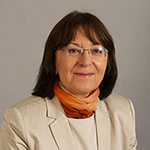 |
Professor Branka DimitrijevicFind out more about Professor Dimitrijevic's work. |
Information Communication Technology (ICT) and the promise of availability of ‘big data’ related to the natural and built environment, and to the current social and economic conditions, are opening new research horizons on their application for the common good. The potential availability and transfer of data in real time, via sensors to the Internet of Things (IoT) platforms, should enable more efficient and effective decision-making and stimulate greater social interaction and wider public engagement in collaborative economic activities. The ‘smart city’ concept, enabled by IoT platforms, can be applied to a settlement of any size.
How can ICT and data be used to achieve our common goals of maintaining a healthy natural environment and providing a good quality of life for everyone? What applications of ICT and data are emerging, and what should the focus be in forthcoming years?
What new capabilities and skills must the research community develop to be able to fully engage in this new research area? How can planners and citizens, architects and building occupants use ICT and data to inform and engage in decision making on planning, design and management of the built environment, and sensitive use of natural resources?
Recent paper
My recent paper Application of ICT for Urban Regeneration, Environmental Protection and Social Equality in Scotland aimed to identify some emerging practices and highlight what research capabilities should be further developed.
Regarding the planning and regeneration of settlements, traditional methods for acquiring baseline data and information include surveys and reports on economic, social and environmental conditions, as well as on built assets and infrastructure systems. The ‘smart city’ concept entails the collection of some data via sensors, e.g. on environmental conditions – quality of air, water, soil, biodiversity; and on infrastructure systems’ capacity, condition, failures, etc. Real-time data on the environmental conditions and the performance of built assets provide feedback to decision-makers on interventions which should be considered as priorities and lessons on the appropriateness of past solutions.
Advantages of digital connectivity
Social equality comprises a range of social issues, but the focus of my paper is on equal access to goods and services through digital connectivity. Digital connectivity provides various opportunities and advantages, such as:
- increasing social inclusion via digital access skills
- informing on local food production and waste reduction
- new methods of providing health services
- easier access to education
- easy access to information about employment opportunities
- increased safety of urban areas
- sharing of resources and skills through ‘collaborative commons’.
Identifying potential barriers
When considering the opportunities for using ICT and data, it is necessary to identify potential barriers and how they could be overcome. Decision-makers cannot understand the meaning of a large quantity of data if it is not presented and analysed in a meaningful way. They also need adequate tools to make optimal decisions based on a clear understanding of the data and commonly-agreed improvement goals. When decisions are made, they have to be communicated to all stakeholders. Following the application of decisions, stakeholders should be able to provide feedback to decision-makers about the decisions’ effectiveness and impact, in order to inform future decision-making.
While it is relatively easy to manufacture sensors and transfer data to IoT platforms, developing data representation, analysis and decision-making tools, communicating decisions to the stakeholders, monitoring the effectiveness of decisions and their impacts, and providing feedback to the decision-makers are areas which currently require new research and development.
If some of the above research areas are of interest to you, please do get in touch.
